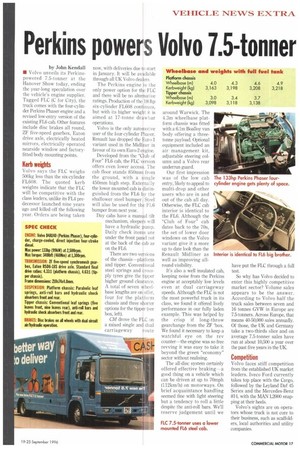Perkins powers Volvo 1.5-tonner
Page 19

If you've noticed an error in this article please click here to report it so we can fix it.
by John Kendall • Volvo unveils its Perkinspowered 7.5-tonner at the Hanover Show today, ending the year-long speculation over the vehicle's engine supplier. Tagged FLC (C for City), the truck comes with the four-cylinder Perkins Phaser engine and a revised low-entry version of the existing FL6 cab. Other features include disc brakes all round, ZF five-speed gearbox, Eaton drive axle, electrically heated mirrors, electrically operated nearside window and factoryfitted body mounting points.
Ketb weights
Volvo says the FLC weighs 500kg less than the six-cylinder FL608. The quoted kerb weights indicate that the FLC will be competitive with the class leaders, unlike its FL4 predecessor launched nine years ago and killed off the following year. Orders are being taken now, with deliveries due ID start in January. It will be available through all UK Volvo dealers.
The Perkins engine is the only power option for the FLC and there will be no alteanative ratings. Production of the,184)hp six-cylinder FL608 conainues, but with its higher weight it is aimed at 17-tonne drawbar operations.
Volvo is the only automotive user of the four-cylinder Phaser.
Renault has dropped the E 1
un)-. variant used in the IVIidliner in favour of its own Euro-2 engine.
Developed from the "Club of Four" FL6 cab, the FU.; wrsion offers even lower access. The cab floor stands 850min from the ground, with a single 450mm high step. Externally the lower mounted cab is distinguished from the FL6 by the shallower steel bumper. Steel will also be used for the 1:1.6 bumper from next year.
Day cabs have a manual tilt mechanism, sleepers will have a hydraulic pump. Daily check items are under the front panel not at the back of the cab as on the FL6.
There are two versions of the chassis—platform and tipper. Conventional steel springs and crossply tyres give the tipper higher ground clearance. A total of seven wheel base lengths are offer, four for the platform chassis and three shorter options for the tipper (see box, left).
CM drove the FLC on a mixed single and dual
carriageway route around Warwick. The 4.3m wheelbase platform chassis was fitted with a 6.Im Boalloy van body offering a threetonne payload. Optional equipment included an air management kit, adjustable steering column and a Volvo rear underrun guard.
Our first impression was of the low cab entry, likely to appeal to multi-drop and other users who are in and out of the cab all day. Otherwise, the PLC cab interior is identical to the FL6. Although the "Club of Four" cab dates back to the 70s, the set of lower door windows on the Volvo variant give it a more up to date look than the Renault 141idliner as well as improving allround visibility.
It's also a well insulated cab, keeping noise from the Perkins engine at acceptably low levels even at dual carriageway speeds. Although the FLC is not the most powerful truck in its class, we found it offered lively performance in our fully laden example. This was helped by the crisp if long-throw gearchange from the ZF 'box. We found it necessary to keep a watchful eye on the rev counter—the engine was so free revving it was easy to take it beyond the green "economy" sector without realising.
The all-disc system certainly offered effective braking –a good thing on a vehicle which can be driven at up to 70mph (112km/h) on motorways. On brief acquaintance handling seemed fine with light steering but a tendency to roll a little despite the anti-roll bars. We'll reserve judgement until we
FLC 7.5-tonner uses a lower mounted F1.6 steel cab.
have put the FLC through a full test.
So why has Volvo decided to enter this highly competitive market sector? Volume sales appears to be the answer. According to Volvo half the truck sales between seven and 16 tonnes GVW in Europe are 7.5-tonners. Across Europe, that means 40-50,000 sales annually. Of those, the UK and Germany take a two-thirds slice and on average 7.5-tonner sales have run at about 10,500 a year over the past five years in the UK.
Competition Volvo faces stiff competition from the established UK market leaders. Iveco Ford currently takes top place with the Cargo, followed by the Leyland Daf 45 Series and the Mercedes-Benz 814, with the MAN L2000 snapping at their heels.
Volvo's sights are on operators whose truck is not core to their business, such as scaffolders, local authorities and utility companies.








































































































